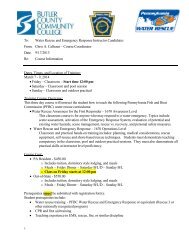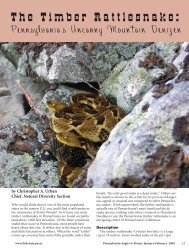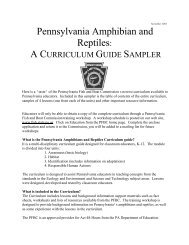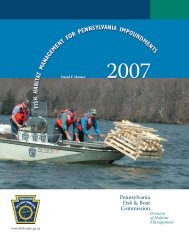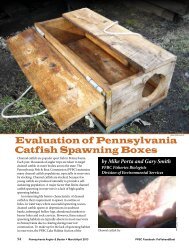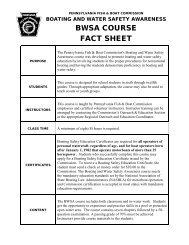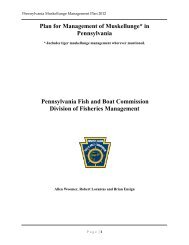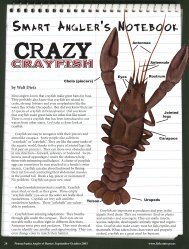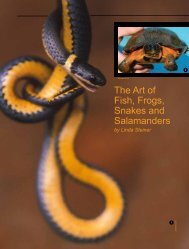^Tn^Z^Ei*] - Pennsylvania Fish and Boat Commission
^Tn^Z^Ei*] - Pennsylvania Fish and Boat Commission
^Tn^Z^Ei*] - Pennsylvania Fish and Boat Commission
You also want an ePaper? Increase the reach of your titles
YUMPU automatically turns print PDFs into web optimized ePapers that Google loves.
tii<br />
or<br />
ot<br />
it><br />
is<br />
:e!<br />
Spinning In Engl<strong>and</strong><br />
Some Worthwhile Tips from Across fhe Sea<br />
By E. BURTON<br />
9 Potuis Court, The Rutts, Bushey Heath, Herts, Engl<strong>and</strong><br />
^Editor's Note; it may be interesting to know<br />
B Mr. Burton is the co-author of "<strong>Fish</strong>erman's<br />
Book" <strong>and</strong> that he also holds the English<br />
?"Jning record on pike. Mr. Burton is a very<br />
i°«flc writer <strong>and</strong> we are certain that our<br />
^ders will enjoy his interesting dissertation.)<br />
: U<br />
Since last writing to the ANGLER, it has<br />
furred to me that your readers would<br />
* 6 to have details of how to make a lure<br />
F spinning tackle that has proved to be<br />
Mnner here.<br />
These lures are easily made, cheap, <strong>and</strong><br />
can be changed at the waterside,<br />
lost important point) <strong>and</strong> finally—THEY<br />
°0 NOT TWIST THE LINE. I have fished<br />
? e of these lures all day on one of the<br />
^6st French nylon lines (monoplament<br />
^'100°) made, this line has a breaking<br />
*ain of only 0.65 kilogram (a kilogram is<br />
bivalent to 2.2046 lbs.) <strong>and</strong> is as fine<br />
* a hair. After a good day's fishing in fast<br />
fitter the line showed no sign of twist.<br />
§* making this lure one will require the<br />
"lowing materials:<br />
R. spoon blade<br />
A- length of stiff fine wire<br />
^ spit ring <strong>and</strong> barrel swivel<br />
6 treble eyed hook<br />
Two small wire springs<br />
.Personally I never use a spoon larger than<br />
/*', my favorite one has a spoon of 1"<br />
By. This of course is a matter of the<br />
t?ter to be fished <strong>and</strong> personal preference.<br />
have found in practice that the old saying<br />
I The larger the bait, the bigger the fish,"<br />
,° 6 s not prove to be correct. A small bait,<br />
; "-ed intelligently will catch big fish, when<br />
^, ge lures <strong>and</strong> plugs are ignored.<br />
SIDE VIEW<br />
ER—194»<br />
45<br />
To get on with making the bait; take<br />
the small split ring <strong>and</strong> put on the swivel,<br />
then take the spoon <strong>and</strong> with a pair of<br />
pliers bend the end to an angle of 45°.<br />
Now place the spoon on the split ring. After<br />
this, take the stiff wire <strong>and</strong> bend one end<br />
into a spring loop, slip the small wire spring<br />
over the long end, hook the loop into the<br />
split ring, pinch together <strong>and</strong> slide the spring<br />
over to grip the end tight. Let the spoon<br />
lay on the wire, push on the other spring,<br />
<strong>and</strong> make another spring loop in the wire<br />
so that when the hook is placed in the loop<br />
it swings freely just below the spoon. This<br />
is most important.<br />
This lure has a very lively action in the<br />
water <strong>and</strong> can be retrieved very slowly<br />
<strong>and</strong> still work well. If it is desired to fish<br />
deep water a little lead wire can be wound<br />
round the wire holding the hook. Without<br />
this extra weight these lures cast about<br />
SPRING SLIPPED OVER<br />
60 to 80 feet, <strong>and</strong> sink about 3 feet per<br />
second. If, in very fast water, they work<br />
on the surface, this can be overcome by<br />
placing a small lead bullet on the leader before<br />
attaching the lure. Cast across a fairly<br />
fast stream, <strong>and</strong> fished slowly, this lure<br />
accounted for 67 lbs. of trout during a recent<br />
holiday in Wales. This is good going from<br />
English st<strong>and</strong>ards. Friends who have made<br />
up larger sizes tell me they are good for<br />
pike, but so far I have not used them pike<br />
fishing. I should be glad to hear of results<br />
should any of the readers of the PENN<br />
SYLVANIA ANGLER care to try out this lure.<br />
It is essentially designed for threadline<br />
however.<br />
FRONT VIEW<br />
BEND HERE<br />
0<br />
WIRE —<br />
HOO<br />
-SWIVEL<br />
-SPLIT RING<br />
—SPOON<br />
George W. Forrest<br />
in the York Gazette <strong>and</strong> Daily<br />
During the past several years there have<br />
been increasing violations recorded against<br />
anglers who run afoul of the <strong>Fish</strong> code<br />
with regard to the taking <strong>and</strong> possession<br />
of minnows for bait fish. Increased fishing<br />
pressure has taken a heavy toll of the minnows<br />
in our small feeder streams. You have<br />
only to try to get bait in your favorite run<br />
these days to acknowledge the truth of this<br />
situation.<br />
Some years ago an angler could make a<br />
couple of swipes with his net <strong>and</strong> have<br />
enough fat minnows to start off on a fishing<br />
trip. Today you work <strong>and</strong> work hard<br />
to secure your allowed 35 <strong>and</strong> you'd better<br />
count 'em <strong>and</strong> recount 'em because any<br />
ever 35 cost you plenty in fines. In hot<br />
weather there are many times you have<br />
trouble keeping minnows alive. I've seen<br />
fellows jam a bucket of bait into the trunk<br />
of the car, drive 30 or 40 miles to a fishing<br />
spot <strong>and</strong> wondered why their bait died on<br />
the way. When this happens, there's nothing<br />
to do but start all over again. This means<br />
that 70 minnows have been cleaned out of<br />
our streams which doesn't conserve our<br />
dwindling supply at all.<br />
There are many schemes <strong>and</strong> devices used<br />
by anglers to keep minnows fresh <strong>and</strong> lively.<br />
Water temperature is important. I've observed<br />
anglers taking minnows from the<br />
cold water of a spring run in the bucket<br />
<strong>and</strong> plunk them direct into the warm water<br />
of the river . . . that was all for the minnows!<br />
The other day I saw a new outfit on<br />
the market which looks like a regular floating<br />
minnow pail with an aerator attached<br />
operated with a "hot shot" dry battery from<br />
your boat, your car battery or a small dry<br />
cell unit attached. The rubber hose connection<br />
leads into the bucket <strong>and</strong> virtually<br />
throws oxygen into the water with a constant<br />
stream of air. The entire outfit is<br />
light, easy to h<strong>and</strong>le <strong>and</strong> appears to be an<br />
excellent method of conserving our bait<br />
fish.<br />
21


![^Tn^Z^Ei*] - Pennsylvania Fish and Boat Commission](https://img.yumpu.com/12335467/23/500x640/tnzei-pennsylvania-fish-and-boat-commission.jpg)

